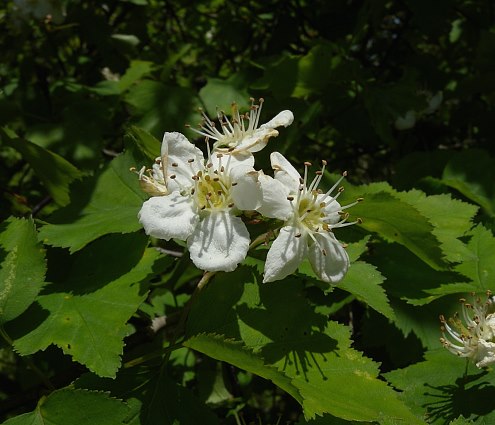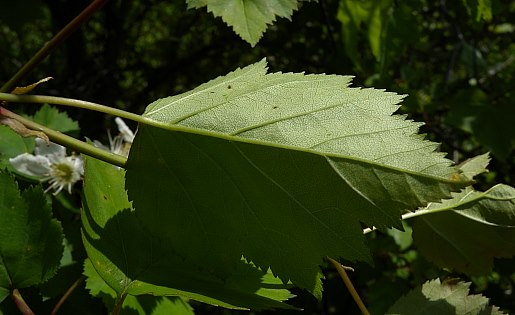Description: This species is a shrubby tree about 10-20' tall, branching irregularly and widely. The small trunk is up to 8" across with gray bark that is rough and scaly. Branch bark is gray and more smooth, sometimes appearing glaucous. Young twigs are reddish brown and smooth; they are usually crooked. Long thorns up to 2½" long appear occasionally among the branches and twigs; they are usually straight, but sometimes slightly curved. The alternate leaves are 1¼-2½" long and 1-2" across; they are oval-ovate or oval-deltate in shape and widest below the middle. The leaves are rounded, truncate, or slightly cordate at the base, and they have broad-pointed tips. Leaf margins are shallowly cleft with 3-4 lobes on both sides and doubly serrated. The upper surface of the leaves is blue-green, green, or yellowish green, while the lower surface is more pale; both surfaces are glabrous. Small emergent leaves are often reddish before they assume the coloration of mature leaves. Leaf venation is pinnate; the primary lateral veins terminate at the tips of the teeth and lobes, rather than their sinuses. The slender petioles are relatively long (¾-2" in length), light green to red, and hairless.

Short-stalked corymbs of flowers are produced from the axils of the leaves; usually only a few flowers are produced per corymb. The peduncle and pedicels of the corymb are light green and glabrous. Individual flowers are ¾-1" across, consisting of a light green calyx with 5 lanceolate teeth, 5 white petals, 20 stamens, and a pistil with 3-5 styles. The calyx is hairless; its teeth have serrated margins. The anthers of the stamens are pink (less often yellow); they become brown with age. The blooming period occurs during late spring for about 2 weeks. Fertile flowers are replaced by small globoid pomes (about ½" across) containing 3-5 seeds. Pomes become mature during the fall. At this time, they have a red to purple exterior that is glabrous and sometimes glaucous; the fleshy interior is dry and hard. Waxy-Fruited Hawthorn spreads by reseeding itself.
Cultivation: The preference is full to partial sun, mesic to dry conditions, and soil containing loam, clay-loam, or rocky material. For some species in this genus, cedar-apple rust can discolor and weaken the foliage.
Range & Habitat: Waxy-Fruited Hawthorn is occasional in NE, east-central, and southern Illinois, while in other areas of the state it is uncommon or absent. However, it may be more common than records indicate. This species is native to Illinois and other areas of eastern United States. Habitats consist of upland rocky woodlands, upland savannas, woodland edges, thickets, fence rows, and abandoned pastures. Like many other hawthorns, this is a pioneer species that spreads into disturbed areas where there is sufficient sunlight.
Faunal Associations: The nectar and pollen of the flowers of hawthorn trees (Crataegus spp.) attract a variety of insects, including honeybees, bumblebees, Halictid bees, Andrenid bees (Andrena), Syrphid flies, dance flies (Empididae), Calliphorid flies, and Muscid flies; less common visitors include wasps and butterflies (Robertson, 1929). Other insects bore through the wood, such plant sap, feed on leaves, and consume other parts of these small trees. They include larvae of long-horned beetles, leaf beetles, weevils, larvae of gall flies, plant bugs, many aphids, leafhoppers, treehoppers, mealybugs, larvae of sawflies, larvae of many moths, and larvae of such butterflies as the Striped Hairstreak (Satyrium liparops strigosum) and Red-spotted Purple (Limenitis arthemis astyanax). See the Insect Table for a more complete list of these insect feeders. Among vertebrate animals, such birds as the Wood Duck, Cedar Waxwing, Hermit Thrush, American Robin, Gray Catbird, Wild Turkey, Bobwhite Quail, and Ruffed Grouse feed on the fruits of hawthorn trees. The latter bird also feeds on their buds and leaves. The Bird Table provides a more complete list of these frugivorous bird species. Mammals feeding on these trees include the American Moose, White-tailed Deer (twigs & fruit), Cottontail Rabbit (bark), Gray Fox (fruit), Woodland Vole (fruit, seeds), American Bear (fruit), and Striped Skunk (fruit); see Ludewig & Bowyer (1985), Martin et al. (1951/1961), and Myers et al. (2004) for more information. In addition to a source of food, hawthorn trees tend to be densely branched, compact, and thorny, and they sometimes form colonies. As a result, they provide excellent habitat for the nesting sites of birds and protective cover for many kinds of wildlife.
Photographic Location: A woodland edge at Orchid Hill in Vermilion County, Illinois.

Comments: This is one of many hawthorn species in Illinois; across different populations, it is rather variable. As a group, hawthorns (Crataegus spp.) are difficult to identify; the number of species varies with the taxonomy. Several hawthorn species are regarded as identical to, or variants of, Waxy-Fruited Hawthorn. As a result, Crataegus gattingeri, Crataegus leiophylla, and Crataegus platycarpa, and several others are usually regarded as scientific synonyms of Crataegus pruinosa (Waxy-Fruited Hawthorn). Critical features for identification include flower size, the number of stamens, the color of anthers, the shape and hairiness of the leaves, terminal points of the lateral leaf veins, hairiness of the pedicels, length and curvature of the thorns, and characteristics of the fruit. Waxy-Fruited Hawthorn is somewhat unusual in lacking hairs on its leaves, young leafy shoots, and pedicels, while its flowers (with 20 stamens) are larger than average in size for species in this genus. Another common name of Crataegus pruinosa is Frosted Hawthorn.